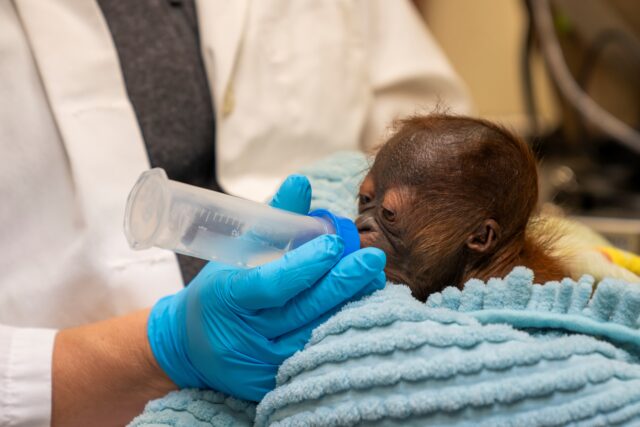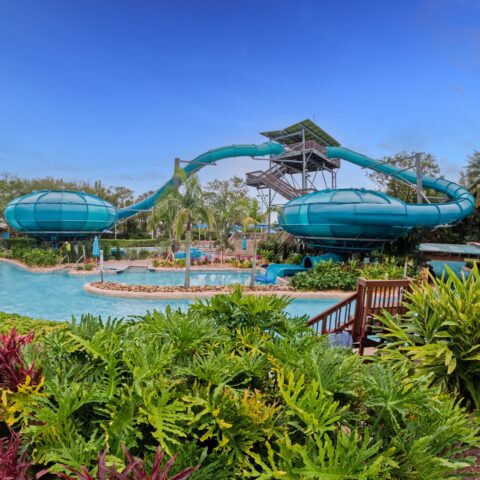3rd April 2012... Research conducted by Busch Gardens Tampa and leading thermal biologists Dr Esther Finegan and Brandon Laforest MSc, has shown that Asian elephants lose most of their body heat, built up during the day, from the surface of their trunks overnight, in contrast to African elephants who cool off after sunset from the surface of their large ears.
Using state-of-the-art FLIR thermal-imaging cameras, a team of scientists and keepers at Busch Gardens were able to undergo an in-depth study into which surface areas of the elephants remained hottest throughout the night, and thus from which areas most heat was lost back into the cool night sky.
Thermoregulation, which is the process by which animals maintain a fairly stable core body temperature despite fluctuations in their environment, is essential for all creatures, but may be particularly challenging for very large mammals such as elephants, who have the smallest surface area, compared to their volume of body tissues, over which heat can be lost.
Otto Fad, Assistant Curator, Elephants, Busch Gardens comments; “Understanding how elephants dissipate stored body heat overnight provides an informed basis for determining under what specific weather conditions elephants should be sheltered inside, while validating our management philosophy that they should sleep outside under the stars the majority of the time. The findings of this ongoing work will have ramifications in elephant management policies and habitat design as we continue to seek the highest levels possible of animal welfare for our elephants.”
Dr Finegan from the University of Guelph, Canada, who studies thermoregulation in a number of mammal species, and who headed up the study with Busch Gardens comments: “The conservation aim of the study was to start investigating what elephants need in order to be thermally comfortable. Subsequent parts of this research study are assessing the importance of shade and water during daylight hours in allowing the elephants to remain comfortably cool during the summer. Previous studies have shown that some mammals may eat less during hot weather, while others do not breed successfully in hot weather.”
Thermal imaging has been used for a number of years in both biological and veterinary studies, with early studies of zoo animals and their outdoor enclosures dating back to the early 1990’s. The current research highlights the potential value of thermal imaging in the low-stress study of exotic and endangered animals, initially in zoological settings.
Notes to Editors
SeaWorld & Busch Gardens Conservation Fund: In addition to direct support of hundreds of environmental, research and conservation projects, the company provides millions of pounds in cash, support and human resources to the SeaWorld & Busch Gardens Conservation Fund. A registered non-profit conservation foundation, the Fund has granted over £9 million in support of projects around the world. It also provides an outlet for visitors to the parks, as well as the general public, to help protect wildlife.
Successful Breeding Programs and Research: Many of the species that call SeaWorld Parks & Entertainment home were born at the parks. The success of these breeding programs is evidence of healthy and well-adapted animals, and the data gained has added immeasurably to the scientific understanding of animal biology and reproductive physiology.
Busch Gardens currently participates in more than 35+ Species Survival Plans (SSPs), collaborative efforts among Association of Zoos & Aquariums-accredited zoological institutions to help protect and preserve threatened and endangered animals for generations to come. Some of the animals bred at Busch Gardens in accordance with SSP guidelines include the cheetah, African lion, Bengal tiger, Western lowland gorilla, Bornean orangutan, black rhinoceros, chimpanzee and Grevy’s zebra.
The parks’ acclaimed veterinarians also operate the SeaWorld & Busch Gardens Reproductive Research Center, a collaborative resource that pioneers technology and research to help with the management and conservation of wildlife and ensure genetic diversity in captive populations throughout the world.
Environmental Partnerships: SeaWorld Parks supports more than 100 environmental organisations worldwide. Ranging from local community initiatives to global wildlife research and conservation programs, these partnerships allow the parks to share animal expertise, strengthen on-the-ground efforts to protect wildlife, and educate millions of people. Just a few of these valued partners include National Wildlife Federation, Conservation International, World Wildlife Fund, The Nature Conservancy and National Geographic Society.
Rescue and Rehabilitation: A global leader in animal care and conservation, SeaWorld Parks & Entertainment cares for more than 7,000 marine and terrestrial animals including 200 endangered or threatened species. This commitment extends to animals around the world: The company has contributed more than $2.5 million in 2012 alone, to ensure the sustainability of animal species in the wild. SeaWorld has rescued more than 25,000 orphaned, injured or ill animals over four decades.
Back to news

